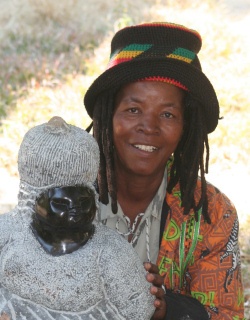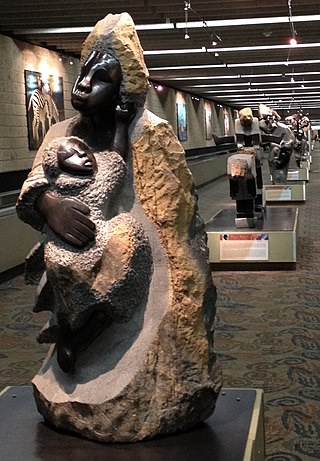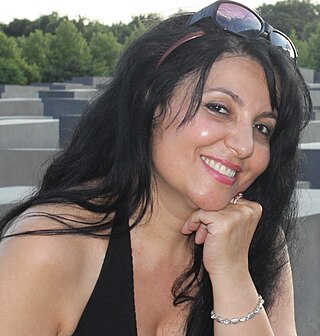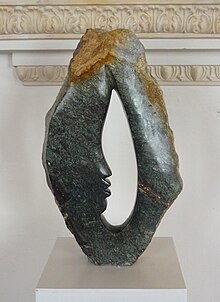
The Kariba Dam is a double curvature concrete arch dam in the Kariba Gorge of the Zambezi river basin between Zambia and Zimbabwe. The dam stands 128 metres (420 ft) tall and 579 metres (1,900 ft) long. The dam forms Lake Kariba, which extends for 280 kilometres (170 mi) and holds 185 cubic kilometres (150,000,000 acre⋅ft) of water.
Kariba is a resort town in Mashonaland West province, Zimbabwe, located close to the Kariba Dam at the north-eastern end of Lake Kariba, near the Zambian border. According to the 2022 Population Census, the town had a population of 27,600.
Nicholas Mukomberanwa, was a Zimbabwean sculptor and art teacher. He was among the most famous protégés of the Workshop School at the National Gallery of Zimbabwe. He was a mentor to the Mukomberanwa Family of sculptors. Mukomberanwa married his first wife, sculptor Grace, in 1965 and they had eight children. In 1965, he decided to end his career with the police to become a sculptor full-time. He continued to hone his skills over the following decade, developing one of the most distinctive personal styles found in his generation of Zimbabwean stone sculptors. The gambit paid off, and by the late 1970s and in the 1980s his work was being shown in many venues. His work has been exhibited in galleries around the world. He also became mentor to many artists in Zimbabwe, including his children Anderson Mukomberanwa, Ennica Mukomberanwa, Lawrence Mukomberanwa, Netsai Mukomberanwa, Taguma Mukomberanwa,Tendai Mukomberanwa and nephew, Nesbert Mukomberanwa who are also sculptors. He remains one of Zimbabwe's most famous artists.
Ennica Mukomberanwa is a Zimbabwean sculptor. The daughter of Grace Mukomberanwa and Nicholas Mukomberanwa, she was trained by the first generation of sculptures. Her work is exhibited in private collections and at galleries around the world. She is a third generation Zimbabwean sculptor. In 2004, she was awarded a prize which allowed her to travel to Stockholm, Copenhagen, Scotland, and Canada. She is a member of the Mukomberanwa family of sculptors. She is the daughter of Grace Mukomberanwa and Nicholas Mukomberanwa, who served as her mentor. She is the sister of sculptors Anderson, Netsai, Taguma, Tendai Mukomberanwa and Lawrence Mukomberanwa, and the cousin of Nesbert Mukomberanwa.
Bernard Matemera was a Zimbabwean sculptor. The sculptural movement of which he was part is usually referred to as "Shona sculpture", although some of its recognised members are not ethnically Shona. His whole professional career was spent at the Tengenenge Sculpture Community, 150 km north of Harare near Guruve.
Boira Mteki, was a Zimbabwean sculptor and educator.

Joram Mariga has been called the “Father of Zimbabwean Sculpture” because of his influence on the local artistic community starting in the 1950s and continuing until his death in 2000. The sculptural movement of which he was part is usually referred to as “Shona sculpture”, although some of its recognised members are not ethnically Shona.
John Takawira, was a Zimbabwean sculptor. The background to the sculptural movement of which he was a leading member is given in the article on Shona art.

Henry Munyaradzi, also known as Henry Munyaradzi Mudzengerere, was a Zimbabwean sculptor. The sculptural movement of which he was part is usually referred to as "Shona sculpture", although some of its recognised members are not ethnically Shona. He worked initially at the Tengenenge Sculpture Community, 150 km north of Harare near Guruve, which he joined in 1967. In that Community, and ultimately in the wider world of lovers of Zimbabwean art, he was known simply as 'Henry'.
Square Chikwanda is a Zimbabwean sculptor, living and working in Harare, Zimbabwe. He first learned his art from his father, also a Zimbabwean sculptor.

Colleen Madamombe (1964–2009) was a Zimbabwean sculptor working primarily in stone. Her work expresses themes of womanhood, motherhood, and tribal Matriarchy.

Fanizani Akuda (1932–2011), also known as Fanizani Phiri, was a Zimbabwean sculptor. He was a member of the sculptural movement "Shona sculpture", although he and some others of its recognised members were not ethnically Shona. He worked initially at the Tengenenge Sculpture Community, 150 km north of Harare near Guruve, which he joined in 1966.
Sylvester Mubayi was a Zimbabwean sculptor.

Agnes Nyanhongo is a Zimbabwean stone sculptor.

Sculpture and in particular stone sculpture is an art for which Zimbabwe is well known around the world.
Bronson Gengezha is a Zimbabwean sculptor.
Celia Winter-Irving, was an Australian-born, Zimbabwean-based artist and art critic who wrote extensively on Zimbabwean art, especially Shona sculpture, when she lived in Harare from 1987 to 2008.

Shahla Aghapour also known as Shahla Aghapour-Benakohell is an Iranian artist, author and gallery director living in Germany. She works both as a writer and poet, as well as a painter, sculptor, performance artist and director of Galerie-Benakohell.
Selmor Mtukudzi is a Zimbabwean musician and actress. She is the daughter of the late Zimbabwean music icon and national hero, Oliver Mtukudzi.
Tarisai Cleopatra Munetsiwa popularly known as Madam Boss is a Zimbabwean comedian, socialite, music artist and actress.








